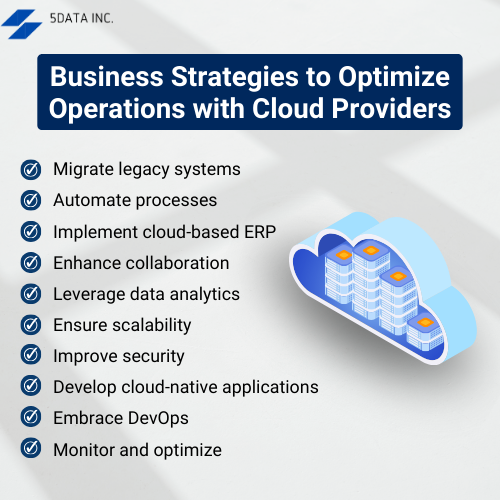Key Takeaways
- The very innovation of cloud computing changes the dynamics of business models.
- Cloud computing has been the safest and most hassle-free technology for organizing companies’ data.
- Cloud plays a crucial role in modern businesses’ digital transformation.
- Cloud combines different models with AI, machine learning, and the Internet of Things to optimize operations for the business world.
Understanding Cloud Technology
Cloud computing technology involves delivering computing services to users over the Internet, enabling users to access and utilize computing resources as and when they need them. Here’s a brief overview of cloud adoption.
Key characteristics of the cloud include:
- On-demand self-service: Users can procure and de-provision resources as needed.
- Broad network access: Resources are accessible via the Internet or a private network.
- Resource pooling: Resources are clubbed together to serve multiple users.
- Rapid elasticity: Resources can be easily altered as per requirement.
- Measured service: Users only pay for the resources they use.
Understanding cloud service models is crucial in modern IT. There are three primary classifications: Infrastructure as a service, platform as a service, and software as a service. Each model serves a specific purpose in delivering computing resources, development platforms, and software applications over the Internet.
Cloud deployment is divided into public, private, and hybrid business models. Hybrid cloud development services work closely with organizations to generate the desired output model.
Cloud computing technologies encompass a range of capabilities that are essential for sustainable success in modern businesses:
- Virtualization
- Containerization
- Cloud Storage
- Cloud Networking
- Cloud Security
How The Cloud Transforms Businesses
The impact of cloud computing and digital technology and the numerous advantages the cloud brings to businesses can be seen in some of the following ways:
1. Enhanced collaboration
Cloud platforms allow teams to access data and applications in real-time, fostering seamless collaboration and enhancing business productivity.
2. Increased agility
Cloud computing allows businesses to modify resources as needed without hefty upfront investments or over-provisioning.
3. Digital transformation strategy
Cloud computing seamlessly integrates the digital era into existing processes, acting as a catalyst for digital transformation initiatives and increasing the focus on customer experience.
4. Cost-effective
Cloud computing operates on a pay-as-you-go model, minimizing upfront costs and allowing businesses to save money and avoid unnecessary expenses.
5. Improved customer service
Cloud computing allows teams to access real-time data, enabling them to deliver exceptional customer service.
6. Increased innovation
Cloud computing enables the scalability and flexibility required to experiment, develop new and innovative solutions, take competitive advantage, and stay at the forefront. Software application development companies assist organizations in integrating the cloud to generate business solutions.
7. Better data security
Cloud computing provides secure storage and built-in backup systems, ensuring business continuity and customer value even in unforeseen circumstances.

Business Strategies to Optimize Operations with Cloud Providers
Leveraging new technologies in the cloud offers a myriad of benefits for business operations, including improved operational efficiency, continuous improvement, cost reduction, customer experience, and enhanced scalability. Here are some effective strategies for optimizing operations with a cloud environment approved by IT leaders:
1. Migrate legacy systems
Consider migrating traditional on-premise systems to the cloud to minimize maintenance and maximize flexibility. Evaluate and prioritize legacy systems for migration based on their business value. Select the appropriate cloud deployment model (private, hybrid, or public cloud) and leverage cloud migration tools and services to streamline the process.
2. Automate processes
To move business outcomes and enhance productivity, leverage cloud-based automation tools to streamline workflows, accelerate time, and reduce manual tasks. Begin by identifying manual business processes that can be automated. Incorporate cloud-based workflow automation tools such as Nintex and K2 and seamlessly integrate automation with your existing systems and applications.
3. Implement cloud-based ERP
Efficiently combine all business operations by implementing a unified, cloud-based Enterprise Resource Planning (ERP) system. Explore and assess different cloud-based ERP options, including SAP, Oracle, and Microsoft Dynamics. Seamlessly integrate ERP with other business systems and applications. Leverage ERP to optimize financials, supply chain, and customer management.
4. Enhance collaboration
Leveraging cloud-based communication and collaboration tools can enhance team connectivity and productivity. Consider implementing cloud-based communication tools like Microsoft Teams and Slack, as well as collaboration platforms such as SharePoint and Google Workspace. Additionally, video conferencing tools like Zoom and Google Meet can be utilized for seamless remote meetings.
5. Leverage data analytics
To drive informed decisions and gain valuable insights, consider leveraging cloud-based data and analytics tools. Take the time to select a suitable cloud-based analytics platform (for example, AWS, Google Cloud, or Azure) and ensure seamless integration with existing big data sources. Additionally, harness the power of machine learning and artificial intelligence to uncover predictive insights that can further enhance your decision-making processes.
Application development services contain the expertise to incorporate cloud technology into data solutions.
6. Ensure scalability
Leverage cloud-based resources for scalability to effectively manage fluctuating workloads. Implement load balancing and autoscaling to optimize performance and constantly monitor and adjust resources as needed to ensure smooth operations.
7. Improve security
Remember to use cloud-based security measures to protect data and ensure compliance. Implement cloud security measures such as IAM and encryption. Utilize various cloud services and security monitoring tools like CloudWatch and Cloud Security.
8. Develop cloud-native applications
Cloud-based development tools like AWS Cloud9 and Google CloudCloud9 can be used to create applications that harness the power of the cloud and its scalability. To enhance your applications’ efficiency and flexibility with cloud infrastructure, incorporate a microservices architecture, containerization (for instance, Docker), and serverless computing.
9. Embrace DevOps
Let’s leverage cloud-based DevOps practices to enhance the efficiency of software development, testing, and deployment. We’ll implement continuous integration and continuous deployment (CI/CD) and utilize DevOps tools such as Jenkins and GitLab CI/CD. Additionally, we’ll work towards fostering a collaborative culture between our development teams and operations teams.
10. Monitor and optimize
Make sure to consistently monitor and enhance cloud resources to guarantee top-notch performance and cost-effectiveness. Utilize cloud monitoring tools like CloudWatch and Azure Monitor. Incorporate cost savings and optimization strategies for cloud-based solutions such as reserved instances and spot instances. Continuously assess and enhance cloud resource utilization.
Conclusion
Implementing these strategies can accelerate your business operations and achieve greater cost efficiency, productivity, and workload mobility through new skills and innovation. They can also unlock the full potential of cloud technology and take your business operations and cloud transformation to the next level. Careful planning is needed to incorporate cloud services successfully while addressing improved reliability, security, and other concerns.
Frequently Asked Questions
What is a cloud computing strategy for a business?
Cloud strategies help businesses maximize benefits such as cost efficiency, scalability, and mobility while minimizing risks and costs. The goal of migration is to ensure company compliance.
What is optimization in cloud computing?
Cloud optimization is the process of selecting the best resources for any given task, thereby increasing efficiency.
How do we navigate the challenges of cloud adoption?
Moving from physical to virtual environments can improve collaboration, but it may also present challenges. Cloud technology offers flexibility and accessibility but relies on internet connectivity and remote data storage, requiring practical solutions to meet business needs.
What is the impact of the cloud on business processes?
Cloud computing reduces operational costs and enables quick, informed decision-making. Automation allows teams to focus on strategic initiatives, creating a workplace of thoughtful decision-making.

